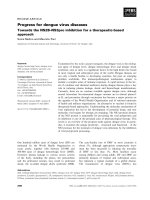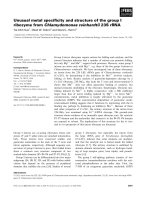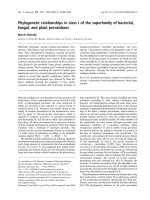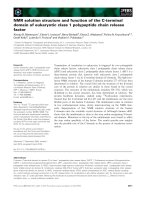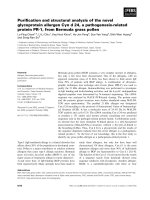báo cáo khoa học: "Meniscoplasty for stable osteochondritis dissecans of the lateral femoral condyle combined with a discoid lateral meniscus: a case report" ppt
Bạn đang xem bản rút gọn của tài liệu. Xem và tải ngay bản đầy đủ của tài liệu tại đây (542.12 KB, 4 trang )
CAS E REP O R T Open Access
Meniscoplasty for stable osteochondritis
dissecans of the lateral femoral condyle
combined with a discoid lateral meniscus: a case
report
Hong-Chul Lim
1
and Ji-Hoon Bae
2*
Abstract
Introduction: Osteochondritis dissecans of the lateral femoral condyle is relatively rare, and it is reported to often
be combined with a discoid lateral meniscus. Given the potential for healing, conservative management is
indicated for stable osteochondritis dissecans in patients who are skeletally immature. However, patients with
osteochondritis dissecans of the lateral femoral condyle combined with a discoid lateral meniscus often have
persistent symptoms despite conservative management.
Case present ation: We present the case of a seven-year-old Korean girl who had osteochondritis dissecans of the
lateral femoral condyle combined with a discoid lateral menisc us, which healed after meniscoplasty for the
symptomatic lateral discoid meniscus wi thout surgical intervention for the osteochondritis dissecans. In addition,
healing of the osteochondritis dissecans lesion was confirmed by an MRI scan five months after the operation.
Conclusions: Meniscoplasty can be recommended for symptomatic stable juvenile osteochondritis dissecans of
the lateral femoral condyle combined with a discoid lateral meniscus when conservative treatment fails.
Introduction
Osteochondritis dissecans (OCD) is a condition of the
joints that appears to primarily affect subchondral bone,
with secondary effects on articular cartilage. Initially,
softening of the overlying articular cartilage is noted
with an intact articular surface; this can progress to
early articular cartilage separation, partial detachment of
an articular lesion, and eventually ost eochondral separa-
tion with a loose body. Etiologic theories of traumatic,
ischemic, accessory ossification center persistence and
various genetic factors have been proposed [1-5].
Several investigators have sho wn subsequently that
there is an increased oc currence of OCD lesions of the
lateral femoral condyle associated with a discoid lateral
meniscus [6-9]. A discoid lateral meniscus might play an
important role in causing OCD of the lateral femoral
condyle among patients who are still growing. Repetitive
abnormal stress on weaker osteochondral structures
produced by a discoid meniscus during growth may
cause OCD of the lateral femoral condyle. Given the
potential for healing, conservative management is indi-
cated for stable OCD in patients who are skeletally
immature. However, patients with OCD of the lateral
femoral condyle combined with a discoid lateral menis-
cus often have persistent symptoms despite conservative
management [8,10].
We present a case of OCD of latera l femoral condyle
combined with a discoid lateral meniscus, which healed
after meniscoplasty for the symptomatic lateral discoid
meniscus without surgical intervention for the OCD.
Case presentation
A seven-year-old Korean girl presented with left knee
pain of three months’ duration. A physical examination
demonstrated a five-degree extension block and tender-
ness on the lateral joint line. The result of a McMurray
test was positive. An MRI scan revealed a complete
* Correspondence:
2
Department of Orthopaedic Surgery, Korea University College of Medicine,
Ansan Hospital, Gojan 1 Dong, Danwon Gu, Ansan Si, Gyeonggi Do, 425-707,
Republic of Korea
Full list of author information is available at the end of the article
Lim and Bae Journal of Medical Case Reports 2011, 5:434
/>JOURNAL OF MEDICAL
CASE REPORTS
© 2011 Lim and Bae; licensee BioMed Central Ltd. This is an Open Access article distribut ed under the terms of the Creative Commons
Attribution License ( which permits unrestricted use, distri bution, and reproduct ion in
any medium, provided the original work is properly cited.
discoid lateral meniscus with a bucket handle tear. On
arthroscopy, a complete discoid lateral meniscus with
longitudinal tear was found that extended throughout
the entire meniscus. Subtotal meniscectomy with
reshaping of remnant meniscus tissue was performed.
Our patient had no further symptoms stemming from
the torn meniscus and recovered a full range of motion.
Activity was not restricted following recovery from the
surgical intervention.
Two years after her first operation, our patient pre-
sented with a snapping sound and intermittent pain
involving her right knee. A physical examination at this
time revealed mild tenderness to the lateral joint line,
butallothertestresultsandfindingsfromplainradio-
graphs were normal. An MRI scan showed a complete
discoid lateral meniscus with a 1.5 by 1.5 cm osteochon-
dral lesion involving the posterior articular surface of
the lateral femoral condyle (Figure 1A). There was no
evidence of fluid signal intensity between t he host and
fragment on a T2-weighted MRI scan (Figure 1B). Initi-
ally, our patient was treated with conservative manage-
ment consisting of activity modification. However, our
patient had persistent symptoms despite six months of
conservative management and she therefore underwent
operation. On arthroscopy, acompletediscoidlateral
meniscus was identified (Figure 2A). The articular sur-
face of the lateral femoral condyle had normal articular
continuity and contour, but soft ening of cartilage at the
margins of the OCD within the lateral femoral condyle
without breach or fibrillation was found. We performed
meniscoplasty that provided a stable 6 mm peripheral of
the remaining meni scus and no treatment was per-
formed for the OCD lesion (Figure 2B). Post-operatively,
our patient was allowed to begin full weight b earing
without immobilization and started a physical therapy
protocol to impr ove the range of mo tion in her knee.
Five months after the operation, an MRI scan demon-
strated complete resolution of the previous OCD lesion
of the lateral femoral condyle (Figure 3). There was no
restriction of early activity following the surgical inter-
vention. Our patient had no symptoms on either knee
and had returned to full daily activity.
Discussion
The f indings in this case report may support the pro-
posed etiology that a discoid lateral meniscus can pro-
duce repetitive abnormal stress on weaker
osteochondral structures in the growing period, and
Figure 1 (A, B) MRI study s howing a discoi d lateral meni scus with a 1.5 by 1.5 cm oste ochondral lesion i nvolving the posterior
articular surface of the lateral femoral condyle. (C) There was no evidence of fluid signal intensity between host and fragment on a T2-
weighted MRI scan.
Figure 2 (A) Arthroscopic picture showing a complete type of discoid lat eral meniscus of right knee joint and (B) meniscoplasty with
a stable 6 mm peripheral remaining meniscus.
Lim and Bae Journal of Medical Case Reports 2011, 5:434
/>Page 2 of 4
may cause OCD o f the lateral femoral condyle. Mit-
suoka et al. [8] reported the case of a 10-year-old boy
who was treated with partial meniscectomy for a discoid
lateral meniscus without any treatment for OCD of the
lateral femoral condyle. They suggested that an abnor-
mal repetitive loading on weaker osteochondral struc-
tures by the damaged discoid lateral meniscus is
considered to be one of the main causes of OCD of the
lateral femoral condyle. Matsumoto et al. [10] reported
a case with bilateral OCD lesions of the lateral femoral
condyle in which the lesions were successfully healed by
meniscoplasty. They proposed an abnormal contact
force may lead to OCD lesion in the lateral femoral con-
dyle. From t hese observations, our hypothesis is that
correction of abnormal loading to the lateral femoral
condyle by meniscoplasty can result in compl ete healing
of an osteochondral lesion.
Non-surgical treatment including activity modification
is primarily indicated for stable juvenile OCD. It may
include crutches for limited weight bearing as well as
braces or even casts for patients who are non-compliant.
Gauzy et al. [11] followed a group of 30 children to
complete resolution o f symptoms by discontinuing
sports activities. The authors recommended no surgical
intervention because symptoms resolved with disconti-
nuation of sports activities. However, there are concerns
about the conser vativ e treatment such as longer time to
heal and the possibility of recurrence in cases of OCD
of lateral femoral condyle combined with a discoid lat-
eral meniscus. In addition, it is difficult to differentiate
whether OCD or the discoid lateral meniscus is the
cause of symptoms. In our patient’ scase,theOCD
lesion healed and the symptoms improved immediately
aft er meniscoplast y, while conservative trea tment failed.
It is difficult to conclude that healing of the OCD lesion
was a result of meniscoplasty alone, and we cannot
exclude the effect of acti vity modification or the natural
healing process of stable OCD in a growing child. How-
ever, it is our belief that if the discoid lateral meniscus
is combin ed with OCD in the lateral femoral c ondyle,
there is a high possibility that conservative treatment
will fail.
Arthroscopic drilling has been suggested for stable
lesions with an intact articular surface [12-14]. Subchon-
dral drilling creates channels to promote revasculariza-
tion and healing. Several published papers have
described cases of concomitant juvenile OCD of the lat-
eral femoral condyle with discoid lateral meniscus [6-9].
Of those, only one published paper described subchon-
dral bone drilling for an OCD lesio n and repo rted satis-
factory results [8]. In contrast, our patient’s case showed
that meniscoplasty without surgical intervent ion for the
OCD lesion can lead to complete healing of the OCD
lesion five months after the operation.
Conclusions
Meniscoplasty can be recommended for symptomatic
stable juvenile OCD of the lateral femoral condyle com-
bined with a discoid lateral meniscus when conservativ e
treatment fails.
Consent
Written informed consent was obtained from the
patient’s next-of-kin f or publication o f this case report
and any accompanying images. A copy of the written
consent is available for review by the Editor-in-Chief of
this journal.
Author details
1
Department of Orthopaedic Surgery, Korea University College of Medicine,
Guro Hospital, 97 Gurodonggil, Gurogu, Seoul, 152-703, Republic of Korea.
2
Department of Orthopaedic Surgery, Korea University College of Medicine,
Figure 3 Our patient five months after operation. MRI study showi ng complete healing of the osteochondritis dissecans lesion of the lateral
femoral condyle.
Lim and Bae Journal of Medical Case Reports 2011, 5:434
/>Page 3 of 4
Ansan Hospital, Gojan 1 Dong, Danwon Gu, Ansan Si, Gyeonggi Do, 425-707,
Republic of Korea.
Authors’ contributions
HCL performed the operation and was a major contributor to writing the
manuscript. JHB also helped write the manuscript and assisted with the
figures.
Competing interests
The authors declare that they have no competing interests.
Received: 17 April 2011 Accepted: 6 September 2011
Published: 6 September 2011
References
1. Green WT, Banks HH: Osteochondritis dissecans in children. J Bone Joint
Surg Am 1953, 35-A:26-47.
2. Petrie PW: Aetiology of osteochondritis dissecans. Failure to establish a
familial background. J Bone Joint Surg Br 1977, 59:366-367.
3. Mubarak SJ, Carroll NC: Familial osteochondritis dissecans of the knee.
Clin Orthop Relat Res 1979, May:131-136.
4. Flynn JM, Kocher MS, Ganley TJ: Osteochondritis dissecans of the knee. J
Pediatr Orthop 2004, 24:434-443.
5. Guhl JF: Arthroscopic treatment of osteochondritis dissecans. Clin Orthop
Relat Res 1982, Jul:65-74.
6. Aichroth PM, Patel DV, Marx CL: Congenital discoid lateral meniscus in
children. A follow-up study and evolution of management. J Bone Joint
Surg Br 1991, 73:932-936.
7. Irani RN, Karasick D, Karasick S: A possible explanation of the
pathogenesis of osteochondritis dissecans. J Pediatr Orthop 1984,
4:358-360.
8. Mitsuoka T, Shino K, Hamada M, Horibe S: Osteochondritis dissecans of
the lateral femoral condyle of the knee joint. Arthroscopy 1999, 15:20-26.
9. Deie M, Ochi M, Sumen Y, Kawasaki K, Adachi N, Yasunaga Y, Ishida O:
Relationship between osteochondritis dissecans of the lateral femoral
condyle and lateral menisci types. J Pediatr Orthop 2006, 26:79-82.
10. Matsumoto H, Suda Y, Otani T, Niki Y: Meniscoplasty for osteochondritis
dissecans of bilateral lateral femoral condyle combined with discoid
meniscus: case report. J Trauma 2000, 49:964-966.
11. Sales de Gauzy J, Mansat C, Darodes PH, Cahuzac JP: Natural course of
osteochondritis dissecans in children. J Pediatr Orthop B 1999, 8:26-28.
12. Aglietti P, Buzzi R, Bassi PB, Fioriti M: Arthroscopic drilling in juvenile
osteochondritis dissecans of the medial femoral condyle. Arthroscopy
1994, 10:286-291.
13. Anderson AF, Richards DB, Pagnani MJ, Hovis WD: Antegrade drilling for
osteochondritis dissecans of the knee. Arthroscopy 1997, 13:319-324.
14. Bradley J, Dandy DJ: Results of drilling osteochondritis dissecans before
skeletal maturity. J Bone Joint Surg Br 1989, 71:642-644.
doi:10.1186/1752-1947-5-434
Cite this article as: Lim and Bae: Meniscoplasty for stable
osteochondritis dissecans of the lateral femoral condyle combined with
a discoid lateral meniscus: a case report. Journal of Medical Case Reports
2011 5:434.
Submit your next manuscript to BioMed Central
and take full advantage of:
• Convenient online submission
• Thorough peer review
• No space constraints or color figure charges
• Immediate publication on acceptance
• Inclusion in PubMed, CAS, Scopus and Google Scholar
• Research which is freely available for redistribution
Submit your manuscript at
www.biomedcentral.com/submit
Lim and Bae Journal of Medical Case Reports 2011, 5:434
/>Page 4 of 4



